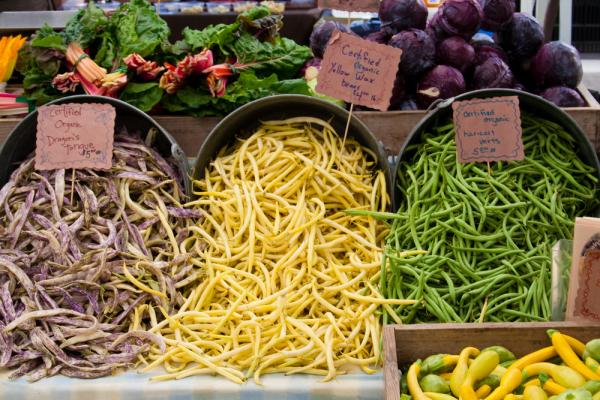I love great food. Last night, I made fresh linguini with organic whole wheat flour and local, free-range eggs, and topped them with from-scratch meatballs made with organic beef, fresh parsley from my garden, fresh Parmesan--you get the idea. And in a few days, I’ll be celebrating a special occasion at one of the finest restaurants in the Northeast, where the produce is local and seasonal and sustainable and where the experience of eating is a little like visiting a museum of fine arts where you get to taste all the masterpieces. And yesterday, I planted the first spring vegetables in my garden. I’m a member of Slow Food USA, for cryin’ out loud.
I’m just waiting for the James Beard foundation to give me a badge for being such a morally superior eater.
Except I’m not. Because while the way I eat is motivated by certain ethical considerations (including but not limited to concern for the health of the environment and that of animals), I’m aware that my way of eating is an almost miraculous privilege. I can eat this way because I happen to live in a place where I can buy eggs from a neighbor and grow vegetables in my backyard. I don’t have much money, but I have the luxury of time to grow my own vegetables, to cook from scratch, and enough wiggle room in the budget to buy 25 pounds of organic flour in bulk (which makes it cheaper) without running out of money before the end of the month.
In a stunning new book, The American Way of Eating,Tracie McMillan goes undercover in farm fields, in the Wal-Mart produce department, and at Applebee’s to explore common assumptions that food-movement types make about the way many Americans eat: that many of us are overweight and unhealthy because we just don’t “care” enough about the quality of our food--with people who are poor “caring” the least. Throughout the book, which chronicles her numerous conversations with low-wage co-workers, McMillan fiercely defends her conviction that everyone--everyone--wants to eat well.
What Barbara Ehrenreich did to demolish the lie that “people who are poor are poor because they’re lazy,” McMillan does here for the elitist assumptions foodies often make. She recounts a horribly classist conversation between a white foodie guy and a Latina woman that went roughly like this:
Latina Woman: What’s a foodie?
White Foodie Guy: It’s like, someone who really, really cares about their food, grows their own food and preserves it and stuff.
LW: Oh, like my mom. She would grow all these vegetables, make fresh salsas and some for preserving, pickle her own jalapenos ...
WFG: No, a foodie’s different—like someone who really, really cares what they eat.
LW: Like. My. MOM.
WFG: No...
LW: That’s so classist, and you do not even get it.
It’s easier to eat well in America than anywhere else in the world, says McMillan, but this ease isn’t available to everyone, even though everyone wants it. Three main things keep good, fresh food out of reach. The first is cost. The second is lack of access (McMillan describes an urban area of Michigan where you’d have to be rich or to drive 30 miles to get fresh produce). And the third is time: working long hours in the field or at Wal-Mart isn’t conducive to cooking a from-scratch dinner in the way, say, working from home as a writer (ahem! like me!) might be.
But McMillan tells us that free fruit and veggies went quicker than donuts in the Wal-Mart break room, fellow farm workers cooked up amazingly fresh Mexican food when they had the time, and everyone told her that they would buy more fresh food if they could afford it.
It’s in everyone’s best interest to fix this, quickly. Federal farm subsidies support the processed foods that are cheapest and easiest for corner stores to stock--the same foods that hurt the health of people who are poor.
A tiny fraction—something around 5 percent—of federal money subsidizes the production of fresh fruit and vegetables. The wages of people who cut our garlic and pick our grapes, says McMillan, could be increased by 40 percent while adding only $16 per year on the produce bill for the average American family.
On a more grassroots level, McMillan points to studies showing that simple, from-scratch cooking classes combined with some basic nutrition education demonstrably improved the diets of people living on limited income while reducing their food bills. (How many empty church kitchens could be put to a use like that?)
There’s nothing wrong with enjoying good—even great—food.
Unless you’re not willing to share.
Rachel Stone has contributed to Christianity Today, Books & Culture, The Progressive Christian, Relevant, Flourish, and other publications. Her first book is forthcoming from InterVarsity Press in 2013, and she blogs daily about food, family, faith and justice from her home in Greenport, NY. Follow her @eatwithjoy.
Produce at Farmer's Market photo, Charles Amundson, Shutterstock.com
Got something to say about what you're reading? We value your feedback!
